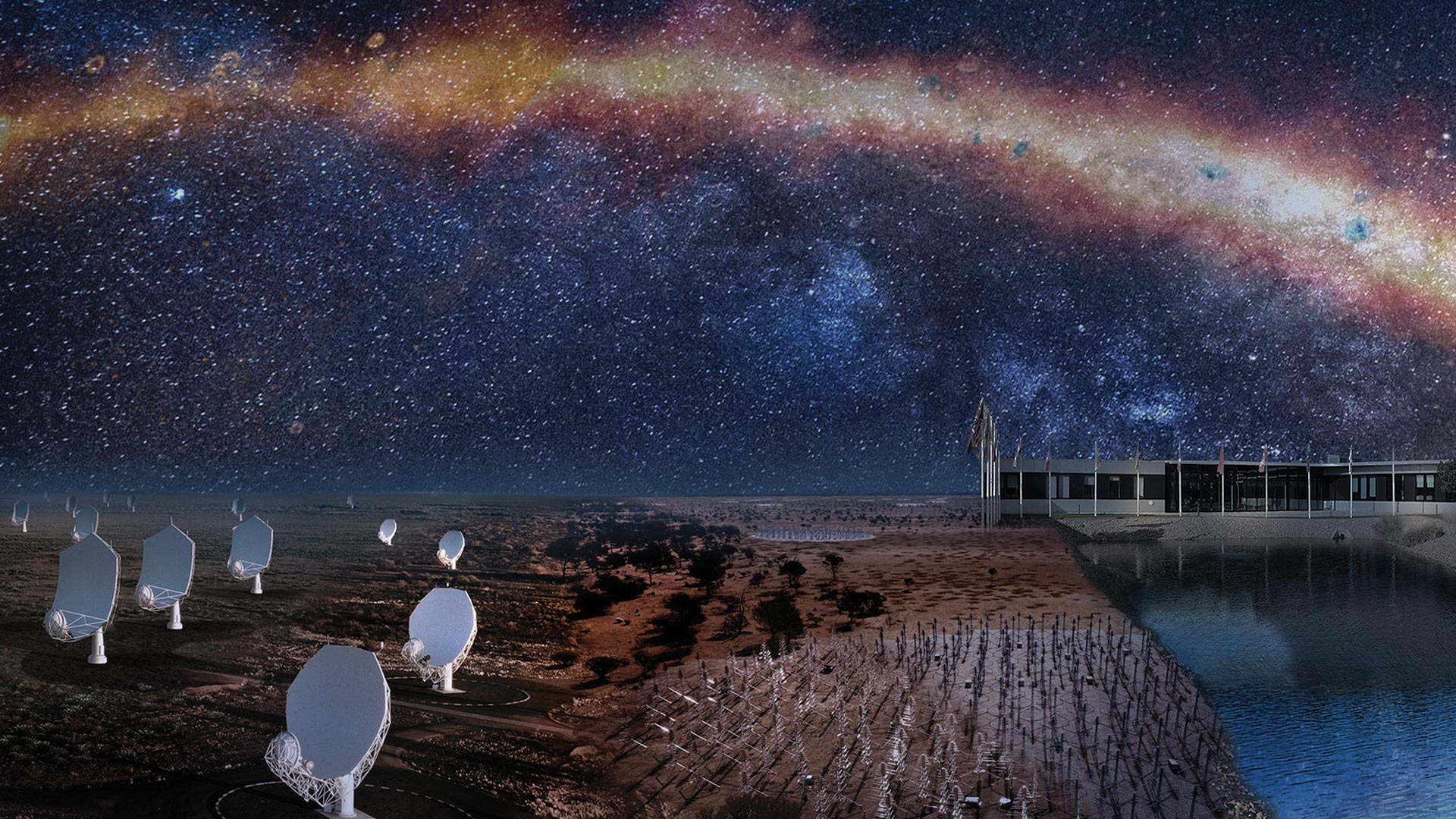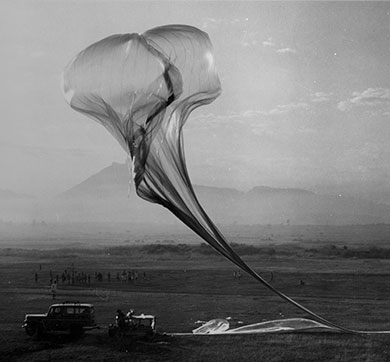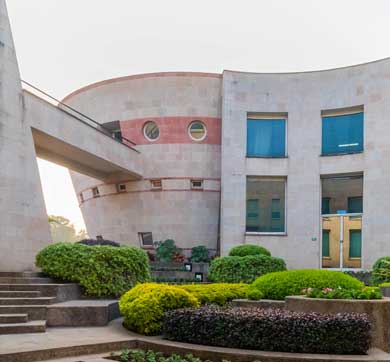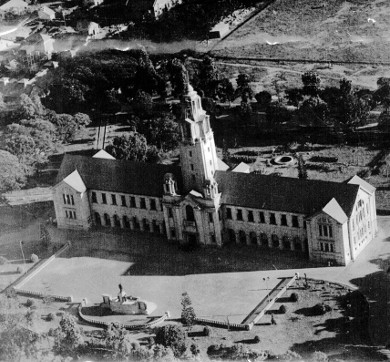July 2021 | 1405 words | 5-minute read
Last year, for the first time ever, a team of Indian astronomers was able to measure the atomic hydrogen content of galaxies seen as they were 8 billion years ago, when the universe was young.
Since galaxies are mostly made up of gas and stars — with gas being converted into stars during the life of a galaxy — understanding them requires data on how the amounts of both gas and stars change with time. This is now the earliest epoch in the universe for which there is a measurement of the atomic gas content of galaxies.
The discovery was made possible using the upgraded Giant Metrewave Radio Telescope (GMRT) in Maharashtra, which is owned and run by the National Centre for Radio Astrophysics (NCRA) of the Tata Institute of Fundamental Research (TIFR). To unravel more such mysteries of the universe, NCRA-TIFR has joined scientists and engineers across the world in setting up the world’s largest radio telescope — the Square Kilometre Array (SKA).
NCRA-TIFR is leading India’s participation in this multi-country programme with the architecture and design of the Telescope Manager (TM), the control system for the SKA telescopes. They collaborated with Tata Consultancy Services (TCS) and global research organisations in the TM design.
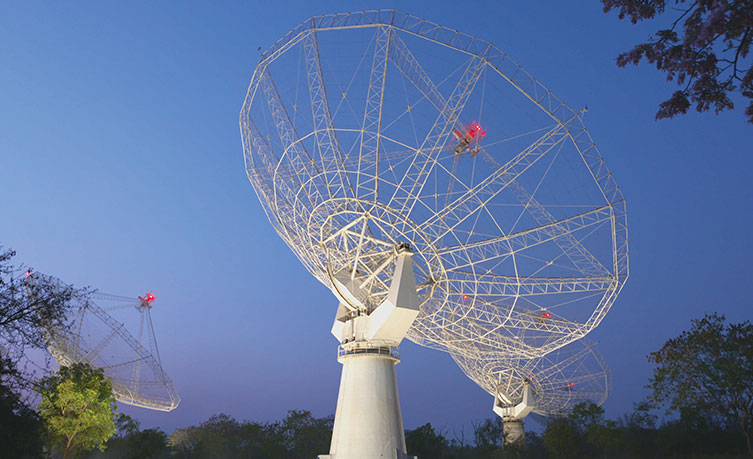
What is SKA?
The SKA is an international programme that aims to set up two telescopes, one in Australia and the other in South Africa, with the observatory headquarters in the United Kingdom. It gets its name from the approximately one square kilometre collecting area it will boast once fully operational. It will be the largest scientific instrument in the history of humankind.
“SKA will eventually use thousands of dishes and up to a million low-frequency antennas that will enable astronomers to monitor the sky in unprecedented detail and survey the entire sky much faster than any system currently in existence,” notes the SKA Observatory (SKAO).
While pre-construction phase of the SKA programme began in 2013, the SKAO was officially launched in February 2021. Construction is scheduled to begin this year and NCRA-TIFR is geared up to join the control system development work, with the knowledge and experience from SKA’s design phase and the implementation of a similar control system for its own GMRT. Its TM monitoring and control system will power communication and coordination with most of the SKA.
“The scale of SKA represents a huge leap forward in science, engineering, and technology. It is exciting to work with the global scientific community on the mega science programme,” says Regu Ayyaswamy, senior vice president and global head, IoT and Engineering and Industrial Services, TCS.
Imagine this*
- Data flowing from the SKA antennas to the onsite signal processor will be transferred 100,000 times faster than the projected global average broadband speed for 2022.
- The SKA will use enough optical fibre to wrap twice around the Earth!
- The computing power required for each of the 2 SKA supercomputers will match that of the best supercomputers in the world.
- Every year, the volume of data stored by the SKA would fill over a million 500GB laptops.
- The SKA will be so sensitive that it will be able to detect an airport radar on a planet tens of light years away.
*Data courtesy: Skatelescope.org
How it began
TCS has been associated with the SKA project since the concept design phase, addressing tough challenges. The project involves two telescopes — one mid frequency and the other low frequency — in two locations, and they differ in terms of hardware as well as control paradigms. The solution also needs to minimise the lifecycle costs associated with the continual technological development, testing, and validation that will occur over the anticipated 50-year lifetime of the telescopes.
“Coming up with a common TM architecture and design that addresses the challenges of geographic distribution of antennae, stringent non-functional requirements posed by the project’s ambitious scientific goals; and scaling up to the SKA needs, was the key challenge,” says Mr Ayyaswamy. “Working as a part of the TM consortium, involving teams from six countries, TCS worked on systems engineering, requirements analysis, architecture and solution design; and participated in prototype development for technology evaluation and mitigating design risks. So far, we have completed the detailed design of the control system.”
He adds, “As the SKA programme enters the construction phase, TCS has been helping with the adoption of agile project execution, developing re-usable assets, and building architectural blocks to kickstart the phase.”
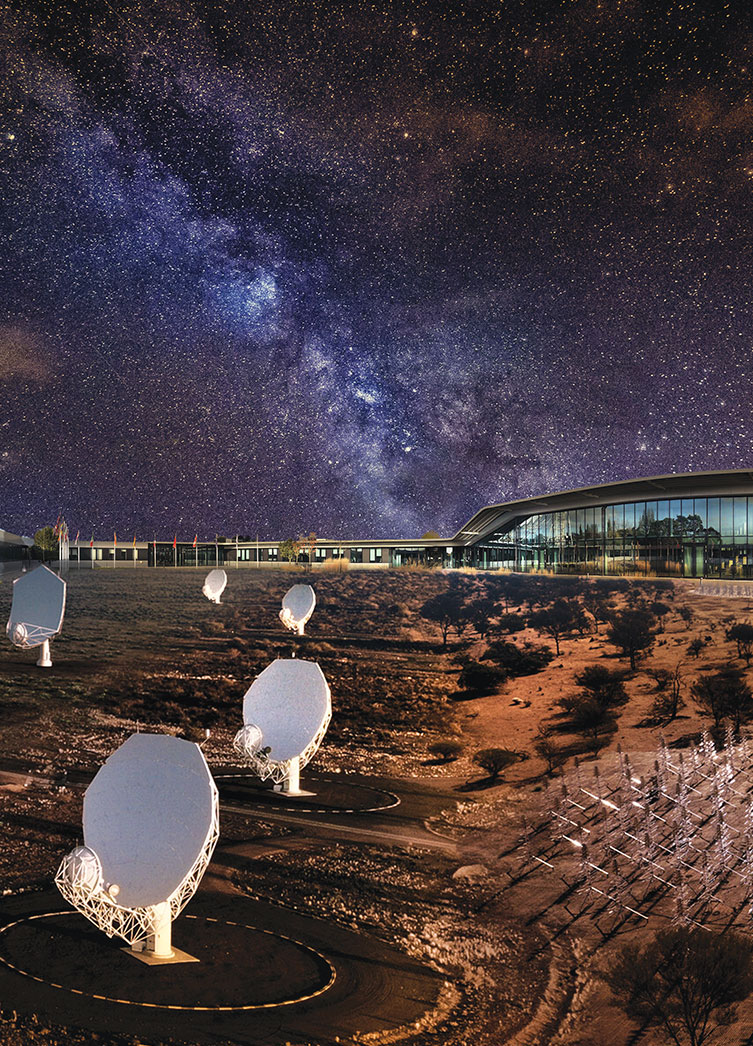
A pathfinder
Joining this journey — as a pathfinder telescope to the SKA — is the GMRT, which was born at the TIFR and given shape by design engineering from Tata Consulting Engineers.
SKAO has chosen certain radio telescope facilities around the world as pathfinder telescopes to leverage the invaluable knowledge of the scientists, engineers and operations teams involved in the building and running of these telescopes. Their knowledge, SKAO recognises, will be useful for the design, construction, commissioning, and operations of the SKA telescopes. The pathfinder telescopes will conduct scientific studies related to SKA activities and help in the development and testing of new SKA technologies.
"The Telescope Manager will act as the brain and nervous system, controlling the entire SKA Observatory.”—Professor Yashwant Gupta, centre director, NCRA
The design and development of GMRT’s new monitoring and control system platform in line with SKA’s preferred technologies, tools, frameworks, and architectural patterns was also done by TCS. The new system uses SKA’s preferred control system framework, TANGO, and the learnings from its development served as useful inputs during SKA’s design phase. While the upgrade has been rolled out for conducting observations on GMRT, enabling astronomers to conquer new frontiers like measuring the atomic hydrogen content of galaxies, it is also intended to serve as a test bed for SKA-related work.
Towards a galaxy far, far away
TCS and NCRA’s collaboration with SKA is the newest chapter in the Tata group’s underreported legacy of powering India’s space exploration aspirations:
- In the early 1960s, Dr Homi Bhabha invited a group of young Indian astronomers from the United States to work at TIFR, setting up the institute’s Radio Astronomy Group. This group led by Professor Govind Swarup, the father of Indian radio astronomy, became the foundation of the NCRA at TIFR.
- TIFR went on to set up the first Indian radio telescope in 1965 at Kalyan (near Mumbai), mainly for solar studies at metre wavelengths.
- In 1971, TIFR commissioned the Ooty Radio Telescope with the largest steerable single antenna. Tata Consulting Engineers (TCE) carried out the concept design, detail engineering, and provided supervision during manufacture and installation of the telescope.
- In 1986, TCE designed Asia’s biggest optical telescope for the Indian Institute of Astrophysics.
- The next major leap was the indigenous design and construction of the NCRA-TIFR’s GMRT near Pune, which went into routine operation in 2000 as the world’s largest radio telescope operating at metre wavelength. Documenting its birth in his book, The Heartbeat of a Trust, Tata group chronicler RM Lala had written, “When the governing council of the TIFR was discussing this project, the scientists said they had the know-how but were daunted by the cost. JRD Tata, as Chairman, encouraged them: ‘Whatever the cost, let us plan the best facility of its kind in the world.’ ” And they did. Astronomers from many countries have reached out to use the GMRT, making it one of the most important radio telescopes of the world.
The Tata way
TCS’s role in the TM consortium as NCRA’s industry partner cements the unique role the Tata group has played in the study of astronomy in India since independence (See above: Towards a galaxy far, far away).
The TCS-NCRA partnership during the design phase of the project laid a solid foundation for India. TM was the first consortium to appear and successfully complete the stringent deliverables assessment amongst other SKA work packages. It better positioned India to participate in the TM construction phase. This is significant because any country that is a part of SKA’s construction phase has the assurance of reserving observation time once the telescopes are operational, opening up hitherto unknown areas of the universe.
“The SKA telescopes will offer 10 to 100 times more sensitivity than existing telescopes and look farther and deeper into space,” says Professor Yogesh Wadadekar of the NCRA. “Scientists will be able to explore the universe with unprecedented clarity to answer questions like: What is dark matter? How did the first stars form?”
—Monali Sarkar
Photos courtesy: SKAO Observatory and National Centre for Radio Astrophysics, TIFR

